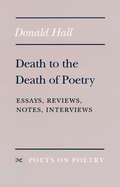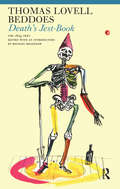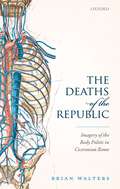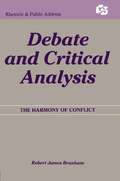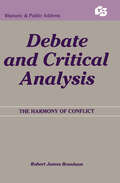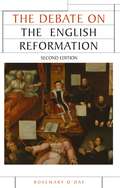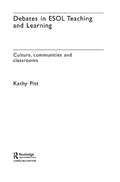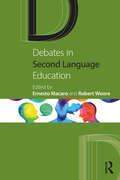- Table View
- List View
Death to the Death of Poetry: Essays, Reviews, Notes, Interviews (Poets On Poetry)
by Donald HallDonald Hall believes that American poetry, at the present moment, thrives both in quality and in leadership. In his latest collection of essays, reviews, and interviews, Hall counters the increasingly publicized view that poetry has an ever-diminishing importance in contemporary American culture. He resents the endlessly repeated cliché that finds poetry unpopular and losing popularity. Thus: Death to the Death of Poetry. Throughout the pages of this latest offering in the Poets on Poetry series, Hall returns again and again to the theme of poetry's health, and offers essays praising contemporary poets, who serve as examples of poetry's thriving condition. In addition, Death to the Death of Poetry collects interviews in which Hall discusses the work of poetry--revisions, standards, the psychology and sociology of the poet's life. The collection will be warmly received by Donald Hall's large readership, enhanced in 1993 by publication of two exemplary volumes: The Museum of Clear Ideas, his eleventh book of poetry; and his essay Life Work, which brought him both new and returning readers. Donald Hall holds degrees from Harvard and Oxford and was recipient of the Lamont Poetry Selection Award, poetry editor for the Paris Review, and Professor of English, University of Michigan, before returning to his ancestral home in New Hampshire.
Death's Jest Book: The 1829 Text (Fyfield Bks.)
by Thomas Lovell BeddoesThis book is Thomas Lovell Beddoes's defining text, a pastiche Renaissance tragedy replete with treachery, murder, sorcery and haunting, the extravagant expression of the poet's lifelong obsession with mortality and immortality. It is a classic of the literature of death.
Death's Jest Book
by Michael BradshawThis book is Thomas Lovell Beddoes's defining text, a pastiche Renaissance tragedy replete with treachery, murder, sorcery and haunting, the extravagant expression of the poet's lifelong obsession with mortality and immortality. It is a classic of the literature of death.
The Deaths of Seneca
by James KerThe forced suicide of Seneca, former adviser to Nero, is one of the most tortured--and most revisited--death scenes from classical antiquity. After fruitlessly opening his veins and drinking hemlock, Seneca finally succumbed to death in a stifling steam bath, while his wife Paulina, who had attempted suicide as well, was bandaged up and revived by Nero's men. From the first century to the present day, writers and artists have retold this scene in order to rehearse and revise Seneca's image and writings, and to scrutinize the event of human death. In The Deaths of Seneca, James Ker offers the first comprehensive cultural history of Seneca's death scene, situating it in the Roman imagination and tracing its many subsequent interpretations. Ker shows first how the earliest accounts of the death scene by Tacitus and others were shaped by conventions of Greco-Roman exitus-description and Julio-Claudian dynastic history. At the book's center is an exploration of Seneca's own prolific writings about death--whether anticipating death in his letters, dramatizing it in the tragedies, or offering therapy for loss in the form of consolations--which offered the primary lens through which Seneca's contemporaries would view the author's death. These ancient approaches set the stage for prolific receptions, and Ker traces how the death scene was retold in both literary and visual versions, from St. Jerome to Heiner Müller and from medieval illuminations to Peter Paul Rubens and Jacques-Louis David. Dozens of interpreters, engaging with prior versions and with Seneca's writings, forged new and sometimes controversial views on Seneca's legacy and, more broadly, on mortality and suicide. The Deaths of Seneca presents a new, historically inclusive, approach to reading this major Roman author.
The Deaths of Seneca
by James KerThe forced suicide of Seneca, former adviser to Nero, is one of the most tortured--and most revisited--death scenes from classical antiquity. After fruitlessly opening his veins and drinking hemlock, Seneca finally succumbed to death in a stifling steam bath, while his wife Paulina, who had attempted suicide as well, was bandaged up and revived by Nero's men. From the first century to the present day, writers and artists have retold this scene in order to rehearse and revise Seneca's image and writings, and to scrutinize the event of human death. In The Deaths of Seneca, James Ker offers the first comprehensive cultural history of Seneca's death scene, situating it in the Roman imagination and tracing its many subsequent interpretations. Ker shows first how the earliest accounts of the death scene by Tacitus and others were shaped by conventions of Greco-Roman exitus-description and Julio-Claudian dynastic history. At the book's center is an exploration of Seneca's own prolific writings about death--whether anticipating death in his letters, dramatizing it in the tragedies, or offering therapy for loss in the form of consolations--which offered the primary lens through which Seneca's contemporaries would view the author's death. These ancient approaches set the stage for prolific receptions, and Ker traces how the death scene was retold in both literary and visual versions, from St. Jerome to Heiner Müller and from medieval illuminations to Peter Paul Rubens and Jacques-Louis David. Dozens of interpreters, engaging with prior versions and with Seneca's writings, forged new and sometimes controversial views on Seneca's legacy and, more broadly, on mortality and suicide. The Deaths of Seneca presents a new, historically inclusive, approach to reading this major Roman author.
The Deaths of the Republic: Imagery of the Body Politic in Ciceronian Rome
by Brian WaltersThat the Roman republic died is a commonplace often repeated. In extant literature, the notion is first given form in the works of the orator Cicero (106-43 BCE) and his contemporaries, though the scattered fragments of orators and historians from the earlier republic suggest that the idea was hardly new. In speeches, letters, philosophical tracts, poems, and histories, Cicero and his peers obsessed over the illnesses, disfigurements, and deaths that were imagined to have beset their body politic, portraying rivals as horrific diseases or accusing opponents of butchering and even murdering the state. Body-political imagery had long enjoyed popularity among Greek authors, but these earlier images appear muted in comparison and it is only in the republic that the body first becomes fully articulated as a means for imagining the political community. In the works of republican authors is found a state endowed with nervi, blood, breath, limbs, and organs; a body beaten, wounded, disfigured, and infected; one with scars, hopes, desires, and fears; that can die, be killed, or kill in turn. Such images have often been discussed in isolation, yet this is the first book to offer a sustained examination of republican imagery of the body politic, with particular emphasis on the use of bodily-political images as tools of persuasion and the impact they exerted on the politics of Rome in the first century BCE.
The Deaths of the Republic: Imagery of the Body Politic in Ciceronian Rome
by Brian WaltersThat the Roman republic died is a commonplace often repeated. In extant literature, the notion is first given form in the works of the orator Cicero (106-43 BCE) and his contemporaries, though the scattered fragments of orators and historians from the earlier republic suggest that the idea was hardly new. In speeches, letters, philosophical tracts, poems, and histories, Cicero and his peers obsessed over the illnesses, disfigurements, and deaths that were imagined to have beset their body politic, portraying rivals as horrific diseases or accusing opponents of butchering and even murdering the state. Body-political imagery had long enjoyed popularity among Greek authors, but these earlier images appear muted in comparison and it is only in the republic that the body first becomes fully articulated as a means for imagining the political community. In the works of republican authors is found a state endowed with nervi, blood, breath, limbs, and organs; a body beaten, wounded, disfigured, and infected; one with scars, hopes, desires, and fears; that can die, be killed, or kill in turn. Such images have often been discussed in isolation, yet this is the first book to offer a sustained examination of republican imagery of the body politic, with particular emphasis on the use of bodily-political images as tools of persuasion and the impact they exerted on the politics of Rome in the first century BCE.
Debate and Critical Analysis: The Harmony of Conflict (Routledge Communication Series)
by Robert James BranhamRather than approach debate primarily as a form of interscholastic competition, this unique book identifies it as an activity that occurs in many settings: scientific conferences, newspaper op-ed pages, classrooms, courts of law, and everyday domestic life. Debate is discussed as an integral part of academic inquiry in all disciplines. As in all fields of study, various competing views are advanced and supported; Debate and Critical Analysis is designed to better prepare the student to assess and engage them. This text posits four characteristics of true debate -- argument development, clash, extension, and perspective -- which form the basic structure of the book. Each concept or aspect of argument covered is illustrated by an example drawn from contemporary or historical sources, allowing the reader to actually see the techniques and strategies at work. All popular forms of competitive debate, including "policy," "Lincoln-Douglas," "value-oriented," and "parliamentary," are discussed in detail -- as embedded in the actual topical controversies with which they are concerned. In this way, the student can learn the structures, reasoning processes, and strategies that may be employed, as well as the practical affairs of debating, from brief-writing to the flowsheet.
Debate and Critical Analysis: The Harmony of Conflict (Routledge Communication Series)
by Robert James BranhamRather than approach debate primarily as a form of interscholastic competition, this unique book identifies it as an activity that occurs in many settings: scientific conferences, newspaper op-ed pages, classrooms, courts of law, and everyday domestic life. Debate is discussed as an integral part of academic inquiry in all disciplines. As in all fields of study, various competing views are advanced and supported; Debate and Critical Analysis is designed to better prepare the student to assess and engage them. This text posits four characteristics of true debate -- argument development, clash, extension, and perspective -- which form the basic structure of the book. Each concept or aspect of argument covered is illustrated by an example drawn from contemporary or historical sources, allowing the reader to actually see the techniques and strategies at work. All popular forms of competitive debate, including "policy," "Lincoln-Douglas," "value-oriented," and "parliamentary," are discussed in detail -- as embedded in the actual topical controversies with which they are concerned. In this way, the student can learn the structures, reasoning processes, and strategies that may be employed, as well as the practical affairs of debating, from brief-writing to the flowsheet.
Debate of the Romance of the Rose (The Other Voice in Early Modern Europe)
by Christine de PizanIn 1401, Christine de Pizan (1365–1430?), one of the most renowned and prolific woman writers of the Middle Ages, wrote a letter to the provost of Lille criticizing the highly popular and widely read Romance of the Rose for its blatant and unwarranted misogynistic depictions of women. The debate that ensued, over not only the merits of the treatise but also of the place of women in society, started Europe on the long path to gender parity. Pizan’s criticism sparked a continent-wide discussion of issues that is still alive today in disputes about art and morality, especially the civic responsibility of a writer or artist for the works he or she produces. In Debate of the “Romance of the Rose,” David Hult collects, along with the debate documents themselves, letters, sermons, and excerpts from other works of Pizan, including one from City of Ladies—her major defense of women and their rights—that give context to this debate. Here, Pizan’s supporters and detractors are heard alongside her own formidable, protofeminist voice. The resulting volume affords a rare look at the way people read and thought about literature in the period immediately preceding the era of print.
Debate of the Romance of the Rose (The Other Voice in Early Modern Europe)
by Christine de PizanIn 1401, Christine de Pizan (1365–1430?), one of the most renowned and prolific woman writers of the Middle Ages, wrote a letter to the provost of Lille criticizing the highly popular and widely read Romance of the Rose for its blatant and unwarranted misogynistic depictions of women. The debate that ensued, over not only the merits of the treatise but also of the place of women in society, started Europe on the long path to gender parity. Pizan’s criticism sparked a continent-wide discussion of issues that is still alive today in disputes about art and morality, especially the civic responsibility of a writer or artist for the works he or she produces. In Debate of the “Romance of the Rose,” David Hult collects, along with the debate documents themselves, letters, sermons, and excerpts from other works of Pizan, including one from City of Ladies—her major defense of women and their rights—that give context to this debate. Here, Pizan’s supporters and detractors are heard alongside her own formidable, protofeminist voice. The resulting volume affords a rare look at the way people read and thought about literature in the period immediately preceding the era of print.
Debate of the Romance of the Rose (The Other Voice in Early Modern Europe)
by Christine de PizanIn 1401, Christine de Pizan (1365–1430?), one of the most renowned and prolific woman writers of the Middle Ages, wrote a letter to the provost of Lille criticizing the highly popular and widely read Romance of the Rose for its blatant and unwarranted misogynistic depictions of women. The debate that ensued, over not only the merits of the treatise but also of the place of women in society, started Europe on the long path to gender parity. Pizan’s criticism sparked a continent-wide discussion of issues that is still alive today in disputes about art and morality, especially the civic responsibility of a writer or artist for the works he or she produces. In Debate of the “Romance of the Rose,” David Hult collects, along with the debate documents themselves, letters, sermons, and excerpts from other works of Pizan, including one from City of Ladies—her major defense of women and their rights—that give context to this debate. Here, Pizan’s supporters and detractors are heard alongside her own formidable, protofeminist voice. The resulting volume affords a rare look at the way people read and thought about literature in the period immediately preceding the era of print.
The Debate on Black Civil Rights in America (Issues in Historiography)
by Kevern VerneyOnce a neglected area, African American history is now the subject of extensive scholarly research. The Debate on Black Civil Rights in America is the first full-length study to examine the changing academic debate on developments in African American history from the 1890s to the present. It provides a critical historiographical review of the very latest thinking and explains how and why research and discourse have evolved in the ways that they have.Individual chapters focus on particular periods in African American history from the spread of racial segregation in the 1890s through to the postwar Civil Rights Movement and the Black Power Movement of the sixties and seventies. The concluding chapters address the modern day black experience and the images of African Americans in popular culture.Appraising both the existing scholarship and the changing philosophy of the historical profession, this work will be invaluable to scholars, students and general readers alike.
The debate on black civil rights in America: Second edition (Issues in Historiography)
by Kevern VerneyThis book examines the historiography of the African American freedom struggle from the 1890s to the present. It considers how, and why, the study of African American history developed from being a marginalized subject in American universities and colleges at the start of the twentieth century to become one of the most extensively researched fields in American history today.There is analysis of the changing scholarly interpretations of African American leaders from Booker T. Washington through to Barack Obama. The impact and significance of the leading civil rights organizations are assessed, as well as the white segregationists who opposed them and the civil rights policies of presidential administrations from Woodrow Wilson to Donald Trump.The civil rights struggle is also discussed in the context of wider, political, social and economic changes in the United States and developments in popular culture.
The debate on black civil rights in America: Second edition (Issues in Historiography)
by Kevern VerneyThis book examines the historiography of the African American freedom struggle from the 1890s to the present. It considers how, and why, the study of African American history developed from being a marginalized subject in American universities and colleges at the start of the twentieth century to become one of the most extensively researched fields in American history today.There is analysis of the changing scholarly interpretations of African American leaders from Booker T. Washington through to Barack Obama. The impact and significance of the leading civil rights organizations are assessed, as well as the white segregationists who opposed them and the civil rights policies of presidential administrations from Woodrow Wilson to Donald Trump.The civil rights struggle is also discussed in the context of wider, political, social and economic changes in the United States and developments in popular culture.
The Debate on Black Civil Rights in America (Issues in Historiography)
by Kevern VerneyOnce a neglected area, African American history is now the subject of extensive scholarly research. The Debate on Black Civil Rights in America is the first full-length study to examine the changing academic debate on developments in African American history from the 1890s to the present. It provides a critical historiographical review of the very latest thinking and explains how and why research and discourse have evolved in the ways that they have.Individual chapters focus on particular periods in African American history from the spread of racial segregation in the 1890s through to the postwar Civil Rights Movement and the Black Power Movement of the sixties and seventies. The concluding chapters address the modern day black experience and the images of African Americans in popular culture.Appraising both the existing scholarship and the changing philosophy of the historical profession, this work will be invaluable to scholars, students and general readers alike.
The Debate on the English Reformation: Second edition (Issues in Historiography)
by Rosemary O’DayExtensively revised and updated, this new edition of The debate on the English Reformation combines a discussion of successive historical approaches to the English Reformation with a critical review of recent debates in the area, offering a major contribution to modern historiography as well as to Reformation studies. It explores the way in which successive generations have found the Reformation relevant to their own times and have in the process rediscovered, redefined and rewritten its story. It shows that not only people who called themselves historians but also politicians, ecclesiastics, journalists and campaigners argued about interpretations of the Reformation and the motivations of its principal agents. The author also shows how, in the twentieth century, the debate was influenced by the development of history as a subject and, in the twenty-first century, by state control of the academy. Undergraduates, researchers and lecturers alike will find this an invaluable and essential companion to their studies.
The Debate on the English Reformation: Second edition (Issues in Historiography)
by Rosemary O’DayExtensively revised and updated, this new edition of The debate on the English Reformation combines a discussion of successive historical approaches to the English Reformation with a critical review of recent debates in the area, offering a major contribution to modern historiography as well as to Reformation studies. It explores the way in which successive generations have found the Reformation relevant to their own times and have in the process rediscovered, redefined and rewritten its story. It shows that not only people who called themselves historians but also politicians, ecclesiastics, journalists and campaigners argued about interpretations of the Reformation and the motivations of its principal agents. The author also shows how, in the twentieth century, the debate was influenced by the development of history as a subject and, in the twenty-first century, by state control of the academy. Undergraduates, researchers and lecturers alike will find this an invaluable and essential companion to their studies.
Debates in ESOL Teaching and Learning: Cultures, Communities and Classrooms (New Approaches to Adult Language, Literacy and Numeracy)
by Kathy PittThis unique book provides a lively introduction to the theory and research surrounding the adult learning of English for Speakers of Other Languages. Offering a digest and discussion of current debates, the book examines a wide geographical and social spread of issues, such as: * how to understand the universal characteristics of learning an additional language* what makes a 'good' language learner* multilingualism and assumptions about monolingualism* learning the written language* the effect of recent Government immigration policy on language learning processes. As a majority of adults learning ESOL are from communities of immigrants, refugees and asylum seekers, understanding the diversity of social and personal history of learners is a critical dimension of this book. It also recognises the social pressures and tensions on the learners away from the classroom and discusses various types of classroom and language teaching methodologies. Full of practical activities and case studies, this book is essential reading for any basic skills teacher undertaking a course of professional development, from GNVQ through to post-graduate level.
Debates in ESOL Teaching and Learning: Cultures, Communities and Classrooms (New Approaches to Adult Language, Literacy and Numeracy)
by Kathy PittThis unique book provides a lively introduction to the theory and research surrounding the adult learning of English for Speakers of Other Languages. Offering a digest and discussion of current debates, the book examines a wide geographical and social spread of issues, such as: * how to understand the universal characteristics of learning an additional language* what makes a 'good' language learner* multilingualism and assumptions about monolingualism* learning the written language* the effect of recent Government immigration policy on language learning processes. As a majority of adults learning ESOL are from communities of immigrants, refugees and asylum seekers, understanding the diversity of social and personal history of learners is a critical dimension of this book. It also recognises the social pressures and tensions on the learners away from the classroom and discusses various types of classroom and language teaching methodologies. Full of practical activities and case studies, this book is essential reading for any basic skills teacher undertaking a course of professional development, from GNVQ through to post-graduate level.
Debates in Second Language Education (Debates in Subject Teaching)
by Ernesto Macaro Robert WooreDebates in Second Language Education provides an up-to-date account of the key debates and areas of controversy in the field of second language learning and teaching. Adopting a broad and comparative perspective and emphasising the importance of considering a variety of learning contexts, it encourages students and practising teachers to engage with contemporary issues and developments in learning and teaching. Chapters are designed to stimulate thinking and understanding in relation to theory and practice, and help language educators to make informed judgements by arguing from a position based on theoretical knowledge and understanding. Bringing together leading contributors in the field, the book discusses a wide range of issues relating to second language learning and teaching including: the relationship between age and success in language learning aptitude versus motivation as predictors of successful language learning linguistic diversity and plurilingualism the teaching of grammar and vocabulary the value of phonics learning pronunciation the second language only versus the multilingual debate With reflective points in every chapter, Debates in Second Language Education will be a valuable resource for any student or practising teacher, as well as for those engaged in initial teacher education, continuing professional development or Master's level study. It will also be of interest to second language acquisition researchers and those studying applied linguistics.
Debates in Second Language Education (Debates in Subject Teaching)
by Ernesto Macaro Robert WooreDebates in Second Language Education provides an up-to-date account of the key debates and areas of controversy in the field of second language learning and teaching. Adopting a broad and comparative perspective and emphasising the importance of considering a variety of learning contexts, it encourages students and practising teachers to engage with contemporary issues and developments in learning and teaching. Chapters are designed to stimulate thinking and understanding in relation to theory and practice, and help language educators to make informed judgements by arguing from a position based on theoretical knowledge and understanding. Bringing together leading contributors in the field, the book discusses a wide range of issues relating to second language learning and teaching including: the relationship between age and success in language learning aptitude versus motivation as predictors of successful language learning linguistic diversity and plurilingualism the teaching of grammar and vocabulary the value of phonics learning pronunciation the second language only versus the multilingual debate With reflective points in every chapter, Debates in Second Language Education will be a valuable resource for any student or practising teacher, as well as for those engaged in initial teacher education, continuing professional development or Master's level study. It will also be of interest to second language acquisition researchers and those studying applied linguistics.
Debates on Stalinism (Issues in Historiography)
by Mark EdeleDebates on Stalinism introduces major debates about Stalinism during and after the Cold War. Did 'Stalinism' form a system in its own right or was it a mere stage in the overall development of Soviet society? Was it an aberration from Leninism or the logical conclusion of Marxism? Was its violence the revenge of the Russian past or the result of a revolutionary mindset? Was Stalinism the work of a madman or the product of social forces beyond his control? The book shows the complexities of historiographical debates, where evidence, politics, personality, and biography are strongly entangled. Debates on Stalinism allows readers to better understand not only the history of history writing, but also contemporary controversies and conflicts in the successor states of the Soviet Union, in particular Russia and Ukraine.
Debates on Stalinism (Issues in Historiography)
by Mark EdeleDebates on Stalinism introduces major debates about Stalinism during and after the Cold War. Did 'Stalinism' form a system in its own right or was it a mere stage in the overall development of Soviet society? Was it an aberration from Leninism or the logical conclusion of Marxism? Was its violence the revenge of the Russian past or the result of a revolutionary mindset? Was Stalinism the work of a madman or the product of social forces beyond his control? The book shows the complexities of historiographical debates, where evidence, politics, personality, and biography are strongly entangled. Debates on Stalinism allows readers to better understand not only the history of history writing, but also contemporary controversies and conflicts in the successor states of the Soviet Union, in particular Russia and Ukraine.
Debates on the German Revolution of 1918-19 (Issues in Historiography)
by Matthew StibbeIn November 1918 a revolution overthrew the old imperial system in Germany and inaugurated a republic. The revolution was formally completed in August 1919 when the social democrat Friedrich Ebert was sworn in as president. By this time, however, many of the revolution’s original aims and intentions had been swallowed up by new political concerns and lived experiences. For contemporaries the meaning of ‘9 November’ changed, becoming increasingly contested between rival parties, military experts and scholars. This book examines how the debate on the revolution has evolved from August 1919 to the present day. It takes the reader through the ideological battles of the 1920s and 30s into the equally politicised historical writing of the cold war period. It ends with a consideration of the marginalisation of the revolution in academic research since the 1980s, and its revival from 2010.
